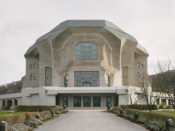Waldorf News
Rudolf Steiner’s Goetheanum in Switzerland Is a Philosophical Masterpiece

By Harriet Thorpe
When Austrian architect and thinker Rudolf Steiner developed his philosophy of Anthroposophy in Germany at the turn of the 20th century, he soon came to require a place from which to spread its teachings of spirituality and science.
Named after German writer Johann Wolfgang von Goethe, whose works Steiner studied and revered, the Goetheanum was therefore born for this purpose on the rising slopes of the Jura Mountains overlooking the town of Dornach, Switzerland.
One of the largest reinforced concrete buildings of its time, the Goetheanum has an enigmatic design that combines the charismatic volume of Gaudí, with the zeal of an Orthodox onion dome and the command of a Brutalist masterpiece.

Photographer Estelle Hanania shot on location at the Goetheanum for Wallpaper* magazine’s March 2018 issue
Perhaps surprisingly, its form grew directly from its function as a venue for performance and learning. Steiner compared the Goetheanum to a shell shaped around its kernel. Steiner’s kernel was the living and breathing activity of the main theatre with 1000 seats at the heart of the plan. From here, performance spaces, rehearsal rooms, classrooms and offices evolve as if Steiner was building from inside to out.
Steiner applied Goethe’s laws of metamorphosis to architecture, designing each part of the building as a cog in the greater machine with a greater purpose: colonnaded corridors circulate the main auditorium like devoted veins transmitting information into the heart of the vessel and cavernous staircases peel out like organ pipes sculpting the movement of sound.

The Goetheanum’s smaller lecture theatre which is used today for educational conferences. Photography: François Coquerel
The sculptural fluidity of the architecture derives from Steiner’s original timber building that stood on the same site and was destroyed by arson on the New Year’s eve of 1923 – it’s concrete descendent that stands today completed in 1928, three years after Steiner’s death in 1925.
While at moments decorative, the interior details are still pure expressions of the Goetheanum’s vocation; stained glass windows reflect the path to self-development through pictorial shading; phenomenal hues alight the space with sublime colour; and carvings on plinths and architraves trace the evolutionary phases of the earth – completing Steiner’s architectural manifestation of his philosophy.

Steiner’s design form grew directly from its function as a venue for performance and learning. Photography: François Coquerel

Steiner compared the Goetheanum to a shell shaped around its kernel. Photography: François Coquerel

Colonnaded corridors circulate the main auditorium like devoted veins transmitting information into the heart of the vessel and cavernous staircases peel out like organ pipes sculpting the movement of sound. Photography: François Coquerel

The Goetheanum as featured in Wallpaper* magazine’s March 2018 issue, shot by photographer Estelle Hanania

Carvings on plinths and architraves throughout the building trace the evolutionary phases of the earth, completing Steiner’s architectural manifestation of his philosophy. Photography: François Coquerel
From wallpaper.com
 Everything a Teacher Needs
Everything a Teacher Needs ~ Ensoul Your World With Color ~
~ Ensoul Your World With Color ~ Caring for All Stages of Life
Caring for All Stages of Life Summer Programs - Culminating Class Trips
Summer Programs - Culminating Class Trips Great books for Waldorf Teachers & Families
Great books for Waldorf Teachers & Families Flexible preparation for your new grade
Flexible preparation for your new grade Jamie York Books, Resources, Workshops
Jamie York Books, Resources, Workshops Immersive Academics and Arts
Immersive Academics and Arts Waldorf-inspired Homeschool Curriculum
Waldorf-inspired Homeschool Curriculum Quality Education in the Heartland
Quality Education in the Heartland The Journey is Everything
The Journey is Everything Grade Level Training in Southern California
Grade Level Training in Southern California Training in Traumatology & Artistic Therapies
Training in Traumatology & Artistic Therapies Bringing Love to Learning for a Lifetime
Bringing Love to Learning for a Lifetime Full-Time Teacher Education
Full-Time Teacher Education Association for a Healing Education
Association for a Healing Education Waldorf Stories for Everyone
Waldorf Stories for Everyone Roadmap to Literacy Books & Courses
Roadmap to Literacy Books & Courses Bay Area Teacher Training
Bay Area Teacher Training Waldorf Training in Australia
Waldorf Training in Australia Space speaks. Its language is movement.
Space speaks. Its language is movement. Grade-specific web courses for teachers
Grade-specific web courses for teachers Train to Teach in Seattle
Train to Teach in Seattle Transforming Voices Worldwide
Transforming Voices Worldwide Preparing Teachers for 2024-25 Grades 1-8
Preparing Teachers for 2024-25 Grades 1-8 Middle School Science With Roberto Trostli
Middle School Science With Roberto Trostli RSS Feeds
RSS Feeds